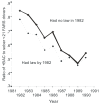The relationship of 16 underage drinking laws to reductions in underage drinking drivers in fatal crashes in the United States
- PMID: 18184512
- PMCID: PMC3217505
The relationship of 16 underage drinking laws to reductions in underage drinking drivers in fatal crashes in the United States
Abstract
The minimum legal drinking age 21 (MLDA 21) legislation in the United States (U.S.) has been documented as one of the most effective public health measures adopted in recent times. This study reports on an effort to evaluate and interrelate a basic set of 16 laws directed at younger than age 21 youth that are designed to (a) control the sales of alcohol to youth, (b) prevent possession and consumption of alcohol by youth, and (c) prevent alcohol impaired driving by those younger than age 21. The first objective of this study was to determine whether there was any relationship between the existence and strength of the various underage drinking laws in a State and the percentage of younger than age 21 drivers involved in fatal crashes who were drinking. After controlling for various factors, the only significant finding that emerged was for the existence and strength of the law making it illegal for an underage person to use fake identification ( p <0.016). The second objective was to determine if the enactment of two of the sixteen provisions (possession and purchase laws) was associated with a reduction in the rate of underage drinking driver involvements in fatal crashes. Analysis of variance (ANOVA) showed that there was a national 11.2% reduction ( p <0.05) in the ratio of underage drinking drivers to underage non-drinking drivers in fatal crashes after the possession and purchase laws were adopted in 36 States and the District of Columbia (DC). This suggests that the two mandatory elements of the Federal MLDA 21 law are having the desired effect of reducing underage alcohol-related highway deaths.
Figures
Similar articles
-
The relationship of underage drinking laws to reductions in drinking drivers in fatal crashes in the United States.Accid Anal Prev. 2008 Jul;40(4):1430-40. doi: 10.1016/j.aap.2008.03.006. Epub 2008 Apr 9. Accid Anal Prev. 2008. PMID: 18606277 Free PMC article.
-
Effectiveness of social host and fake identification laws on reducing underage drinking driver fatal crashes.Traffic Inj Prev. 2014;15 Suppl 1:S64-73. doi: 10.1080/15389588.2014.928929. Traffic Inj Prev. 2014. PMID: 25307400
-
Assessing the Impact of Twenty Underage Drinking Laws.J Stud Alcohol Drugs. 2016 Mar;77(2):249-60. doi: 10.15288/jsad.2016.77.249. J Stud Alcohol Drugs. 2016. PMID: 26997183 Free PMC article.
-
New research findings since the 2007 Surgeon General's Call to Action to Prevent and Reduce Underage Drinking: a review.J Stud Alcohol Drugs. 2014 Jan;75(1):158-69. doi: 10.15288/jsad.2014.75.158. J Stud Alcohol Drugs. 2014. PMID: 24411808 Free PMC article. Review.
-
International policies on alcohol impaired driving: are legal blood alcohol concentration (BAC) limits in motorized countries compatible with the scientific evidence?Nihon Arukoru Yakubutsu Igakkai Zasshi. 2003 Apr;38(2):83-102. Nihon Arukoru Yakubutsu Igakkai Zasshi. 2003. PMID: 12784660 Review.
Cited by
-
Improving state health policy assessment: an agenda for measurement and analysis.Am J Public Health. 2012 Sep;102(9):1697-705. doi: 10.2105/AJPH.2012.300716. Epub 2012 Jul 19. Am J Public Health. 2012. PMID: 22813417 Free PMC article. Review.
-
Controlling Underage Drinking: Fear of Law Enforcement or Internalized Normative Values?J Addict Prev. 2013 Nov 22;1(2):6. doi: 10.13188/2330-2178.1000008. J Addict Prev. 2013. PMID: 25243198 Free PMC article.
-
The prevalence of alcohol use disorders among night-time weekend drivers.Addiction. 2011 Jul;106(7):1251-60. doi: 10.1111/j.1360-0443.2011.03408.x. Epub 2011 May 6. Addiction. 2011. PMID: 21342301 Free PMC article.
-
Teen parties: who has parties, what predicts whether there is alcohol and who supplies the alcohol?J Prim Prev. 2014 Dec;35(6):391-6. doi: 10.1007/s10935-014-0361-4. J Prim Prev. 2014. PMID: 25131398 Free PMC article.
-
Adolescent alcohol use: a reflection of national drinking patterns and policy?Addiction. 2014 Nov;109(11):1857-68. doi: 10.1111/add.12681. Epub 2014 Aug 5. Addiction. 2014. PMID: 25041190 Free PMC article.
References
-
- Arnold R. Effect of raising the legal drinking age on driver involvement in fatal crashes: The experience of thirteen states. (DOT HS 806 902) Washington, DC: National Highway Traffic Safety Administration; 1985.
-
- Ferguson SA, Fields M, Voas RB. Enforcement of zero tolerance laws in the US – Prevention Section. In: Laurell H, Schlyter F, editors. Alcohol, Drugs and Traffic Safety – T 2000: Proceedings of the 15th International Conference on Alcohol, Drugs and Traffic Safety; May 22–26, 2000; Stockholm, Sweden: ICADTS; 2000. pp. 713–718.
-
- Hedlund JH, Ulmer RG, Preusser DF. Determine Why There are Fewer Young Alcohol-Impaired Drivers (DOT HS 809 348) Washington, DC: U.S. Department of Transportation; 2001.
-
- Insurance Institute for Highway Safety. U.S. licensing systems for young drivers: Laws as of March 2006. Arlington, VA: Insurance Institute for Highway Safety; 2006.
-
- Insurance Institute for Highway Safety. U.S. licensing systems for young drivers: Laws as of May 2007. Arlington, VA: Insurance Institute for Highway Safety; 2007.
Publication types
MeSH terms
Grants and funding
LinkOut - more resources
Full Text Sources
Medical

